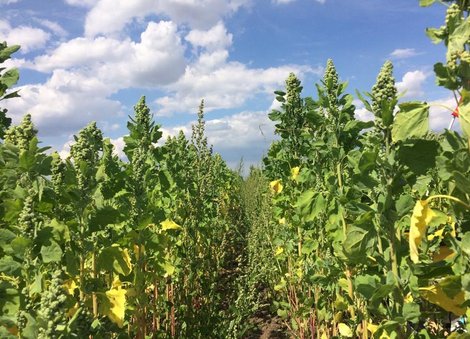Superfood Reinvented: Innovative Nutrition Strategies from Saxony-Anhalt
New and very old plant varieties defy climate change

The Zukunftsspeisen (Food of the Future) project in Saxony-Anhalt is committed to developing innovative, holistic nutrition strategies from field to fork. Since 2019, Urte Grauwinkel and Dr. Toni Meier have been working towards creating sustainable and healthy food for everyone. Supported by agricultural businesses and universities in Saxony-Anhalt, they are establishing new plants, rediscovering old ones and developing innovative cultivation systems. They want to ensure healthy food in an era of climate change.
Superfood from Saxony-Anhalt
The project team behind Zukunftsspeisen believe that millet, quinoa, chickpeas, hemp, amaranth and buckwheat are important foods of the future, for several key reasons. They are highly nutritious thanks to their protein, vitamin and mineral content, are gluten free, making them suitable for those with delicate digestion and, most importantly, can withstand changing climate conditions. Cultivation is being stretched to its limits as summers become drier, hot spells become longer and pests and soil erosion become more common. Due to increasing climate change, it will be extremely difficult in several years’ time to produce sufficient yields from the crops we grow today.
That’s why sustainable plants are being cultivated in initial pilot projects in Saxony-Anhalt. Nurseries and organic farms of varying sizes are pursuing these superfoods in partnership with the Zukunftsspeisen project.
Climate-change-resistant agriculture
The first stage in the food value chain is agriculture. That’s why a key area of research and consultation in the Zukunftsspeisen project is climate-change-resistant agriculture. How can moisture be better retained in soil? Which crops are suitable for cultivation in changed climate conditions? How can we protect soil for the long term and prevent it from eroding? What methods can we use successfully for fertilization and to increase humus content? Several research teams and students are trying to get to the bottom of these questions. Since the beginning of the project, a total of ten science students have written their final dissertations on these topics.
One approach is investigating how vegetable charcoal can keep more moisture in the soil. Vegetable charcoal has been used in the cultivation of millet and quinoa at two different sites with varying soil conditions. “These practical tests have a completely different value to the work we do in the lab,” says Urte Grauwinkel. “For example, we can only identify handling difficulties once we’re using viable farmland.” What’s more, businesses of different sizes have their own different requirements. Practical research and close cooperation with agricultural as well as processing companies and chefs are invaluable for generating results that they can really implement.
From seed to fork
Their practical research also takes holistic principles into account. “The next generation will have no choice but to opt for resource-efficient agriculture and a plant-based diet,” says Grauwinkel. “The aim of the Zukunftsspeisen project is to contribute towards sustainable food sovereignty.” The vision of their work is to ensure that everyone always has access to enough healthy food. That’s why plant selection, cultivation, nutritional support, product development and marketing are all challenges the project is grappling with at the same time.
It is planning to set up a partnership with The Leibniz Institute of Plant Genetics and Crop Plant Research in Gatersleben to source suitable seeds for the sometimes rather exotic plants: quinoa comes from South America and chickpeas from Arab countries.
In conjunction with agricultural businesses, vegetable charcoal and mulching systems are being put to practical use; agroforestry systems should follow in the future. “We need to reinvent agriculture,” says Grauwinkel. “We need new agricultural systems to keep our soil going for the future.” Rather than focusing on constant intensification, sustainable, economic cultivation systems are now what’s needed. Agroforestry is an approach that does just that: it combines the long-standing mixed cultivation of trees and farmland with the latest methods. The practical approaches are being provided with scientific support from the Institute for Agricultural and Nutritional Science, the Research Group for Soil Biogeochemistry at the Martin Luther University Halle-Wittenberg.
But what about millet and its fellow foodstuffs? Nutritional scientist and co-founder of Zukunftsspeisen, Dr. Toni Meier, is convinced that superfoods from Saxony-Anhalt offer a good way of broadening our diets. Authentic-tasting chickpea cheese, buckwheat patties and millet croquets have already been developed. Initial channels of distribution have so far been local and regional markets. The aim is to use the recipes to also get wholesalers and supermarkets on board. The collaboration with the students has generated lots of ideas. One initiative could be to introduce ‘climate change menus’ featuring the products and recipes to university canteens. Consuming meat, butter and dairy products uses an enormous amount of resources; a plant-based diet, on the other hand, is healthy, balanced and environmentally friendly.
A vision of good food for everyone
These developments, which have started out in Saxony-Anhalt, are set to spread far around the world in the years to come. “Climate-change-resistant, resource-efficient and commercial cultivation systems and plants that ensure a balanced, tasty and healthy diet are our future,” says Grauwinkel.
Author: Miriam Fuchs/IMG Saxony-Anhalt

Find out more HERE: > Food industry in Saxony-Anhalt
